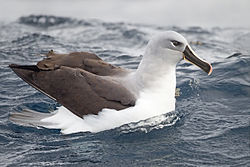The genera of birds (19302114966)
Order VIII. Anseres.
The fifth Family,
LARIDiE, or Gulls,
have the Bill of various forms, more or less straight, and compressed on the sides ; the Nostrils lateral,
generally longitudinal, and submedial ; the Wings lengthened and pointed ; the Tail more or less
long, and of various forms ; the Tarsi generally moderate, strong, and covered in front with transverse
scales ; the Toes moderate, wit h the anterior ones united by a full web ; the hind toe usually short and
elevated.
The first Subfamily,
LARINiE, or Gulls,
have the Bill more or less lengthened, straight, compressed on the sides, with the culmen straight at the
base and curved to the tip, which is acute ; the Nostrils lateral, submedial, and oblong ; the Wings
lengthened and pointed ; the Tail moderate and usually even ; the Tarsi moderate and strong ; the
Toes moderate, the fore toes united by a web, and the hind toe generally short and elevated.
Stercorarius Briss.*
Bill moderate, straight, and strong, with the culmen straight, rounded, and covered with a
membranous or bony cere ; the apex curved, vaulted, and strong ; the gonys much angulated and
ascending; the nostrils placed in the fore part of the cere, narrow, and enlarging anteriorly. Wings
lengthened and pointed, with the first quill the longest. Tail moderate and rounded, with the two
centre feathers sometimes lengthened. Tarsi longer than the middle toe, strong, and covered in front
with strong scales. Toes moderate and strong, the anterior ones united by a full web ; the hind toe
very small, and hardly elevated.
These bold and tyrannical birds are usually seen in pairs, far out at sea, in the higher latitudes of both hemispheres.
Their flight is elevated, and performed in circles, especially when watching some object which has attracted their
attention. They attack, while on the wing, other birds, as terns, gulls, and even the albatross, causing them to drop or
disgorge their food, which they seize before it reaches the water. At other times they feed on the floating carcasses
of cetaceous animals, as well as eggs and young sea birds. Their nests are formed in companies, of coarse grass, on rocks
or on the sands. The eggs are generally one or two in number.
- Brisson established (Ornithologie) this genus in 176'0. Catarracta (1?64) of Brunnich, Lestris (1811) of Illiger, and Pradatrix
Relevantní obrázky
Relevantní články
Albatros šedohlavýAlbatros šedohlavý je velký mořský pták z rodu Thalassarche a čeledi albatrosovitých. Vyskytuje se v jižních oblastech Atlantského, Tichého a Indického oceánu a v severních oblastech Jižního oceánu mezi cca 46–64° j. š. Na souš zalétá pouze za účelem hnízdění. To probíhá v koloniích ve dvou oblastech na jihu od Chile a na několika subantarktických ostrovech, konkrétně Jižní Georgii, Crozetových ostrovech, Kerguelenech, Macquarie, Ostrovech prince Edvarda a Campbellově ostrově, přičemž přibližně polovina hnízdících párů se nachází na Jižní Georgii. Druh byl poprvé popsán v roce 1785 německým přírodovědcem Johannem Reinholdem Forsterem. .. pokračovat ve čtení











